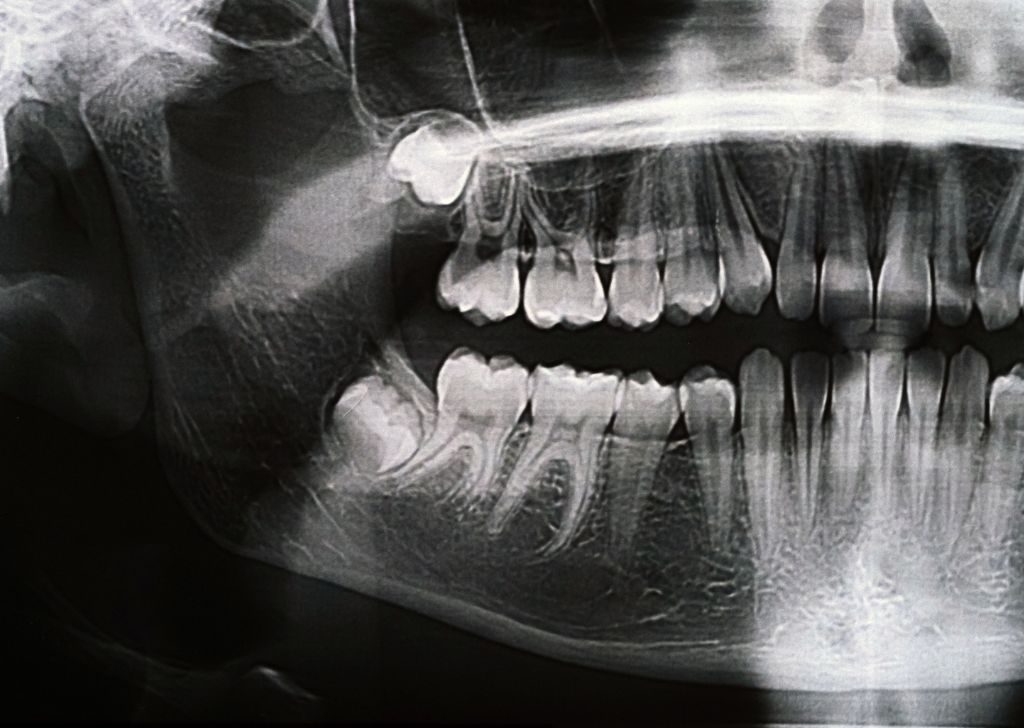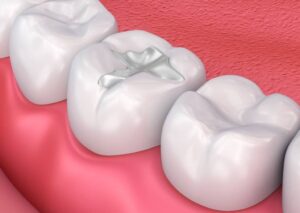What Is an Impacted Wisdom Tooth?
Wisdom teeth, also known as third molars, are the last set of teeth to emerge – usually appearing between the ages of 17 and 25. While some people have enough space in their jaw for these teeth to grow without issues, many do not. When there isn’t enough room, or the tooth grows at an odd angle, it becomes what dentists call impacted.
What “impacted” means vs fully erupted
A fully erupted wisdom tooth breaks through the gum and fits properly into the dental arch. In contrast, an impacted wisdom tooth gets stuck – either under the gum, in the jawbone, or against another tooth. It might be partially visible or completely hidden, but either way, it doesn’t erupt in a normal position.
Impacted teeth don’t just stay quietly beneath the surface. They often press against neighbouring teeth, cause gum irritation, or create pockets where bacteria can thrive. That’s why early detection is key.
Why wisdom teeth are commonly affected
Unlike other teeth, wisdom teeth arrive late to the party. By the time they’re ready to emerge, most of the space in your jaw is already taken up. Evolution has made our jaws smaller over time, but our bodies still try to grow the same number of teeth. That mismatch is the main reason impaction is so common.
On top of that, wisdom teeth can grow in unpredictable directions – horizontally, diagonally, or backwards – causing even more complications if left untreated.
When they usually appear
Wisdom teeth typically begin to develop during the teenage years and start pushing through the gums between ages 17 and 25. This is why dentists often recommend getting X-rays during late adolescence. Not everyone has wisdom teeth, but for those who do, it’s important to monitor their position before they cause pain, crowding, or infection.
Wisdom Teeth Is Such a Nuisance. So Why Do Humans Have It?
 Wisdom teeth might seem like a dental nuisance today, but they actually played a key role in human survival thousands of years ago. These third molars were nature’s way of helping early humans eat a tough, raw diet when dental hygiene and cooking methods didn’t exist.
Wisdom teeth might seem like a dental nuisance today, but they actually played a key role in human survival thousands of years ago. These third molars were nature’s way of helping early humans eat a tough, raw diet when dental hygiene and cooking methods didn’t exist.
How ancient humans used third molars to chew raw plants, nuts, and meat
Our ancestors relied heavily on a coarse diet made up of raw meat, roots, nuts, and fibrous plants. These foods required intense chewing power to break down. Wisdom teeth acted as extra grinders at the back of the mouth, compensating for lost teeth and helping early humans process food more effectively.
Back then, losing a few molars by early adulthood wasn’t unusual, especially with no dental care available. So when wisdom teeth erupted in the late teens or early twenties, they often came in to fill gaps left by fallen teeth. At the time, they were functional and necessary.
Modern jaw size vs ancient jaw size
 Over time, our diets changed. The invention of fire, cooking tools, and softer foods meant we didn’t need to chew as aggressively anymore. As our dietary needs evolved, so did the structure of our jaws. Human jaws gradually became smaller, but the number of teeth we grow stays the same.
Over time, our diets changed. The invention of fire, cooking tools, and softer foods meant we didn’t need to chew as aggressively anymore. As our dietary needs evolved, so did the structure of our jaws. Human jaws gradually became smaller, but the number of teeth we grow stays the same.
That’s where the problem lies. Modern jaws usually don’t have enough space to accommodate four extra molars, leading to crowding, impaction, or misalignment when wisdom teeth try to erupt.
Why wisdom teeth are now considered vestigial
In today’s world, wisdom teeth are more of a liability than an asset. Most people don’t need them to chew, and their late arrival often disrupts the rest of the dental arch. Because they no longer serve a meaningful purpose and tend to cause more harm than good, dentists now classify them as vestigial structures – body parts that were once useful in our evolutionary past but have since become obsolete.
In short, wisdom teeth are evolutionary leftovers. Our bodies still grow them, but our modern jaws can’t quite keep up.
Types of Impacted Wisdom Teeth
 Vertical impaction
Vertical impaction
In vertical impaction, the tooth grows straight but lacks space to erupt. It often presses into the adjacent molar. Though it’s easier to remove, it can still cause crowding or discomfort if left alone.
Horizontal impacted wisdom tooth
This is one of the most painful types. The tooth grows sideways and directly into the neighbouring molar. This not only causes intense pain but can also damage surrounding teeth and gums. Surgical extraction is almost always necessary.
Soft tissue vs hard tissue impaction
Soft tissue impaction occurs when the tooth is trapped under the gum but not the bone. Hard tissue impaction is more complex – the tooth is enclosed by both gum and jawbone, making the extraction process longer and more involved.
How dentists identify them
Dentists use panoramic or 3D dental X-rays to locate impacted wisdom teeth. The scan helps determine the angle, depth, and proximity to nerves – all critical factors in planning a safe extraction.
Symptoms of an Impacted or Infected Wisdom Tooth
 Gum swelling and jaw pain
Gum swelling and jaw pain
One of the earliest symptoms is discomfort at the back of the mouth. Swollen gums, soreness when chewing, or jaw stiffness are often signs of an impacted tooth beneath the surface.
Difficulty chewing or opening mouth
As inflammation grows, you might feel pressure when biting or even difficulty opening your mouth fully. This can affect your eating, speaking, and sleeping patterns.
Signs of wisdom tooth infection
If bacteria become trapped around the partially erupted tooth, it can lead to infection. Watch out for persistent bad breath, an unpleasant taste, swollen gums, or red patches around the area.
Infected wisdom tooth symptoms: fever, pus, bad breath
A full-blown infection can cause fever, white or yellow pus around the gums, and intense pain. Left untreated, it may spread to other areas of the jaw or bloodstream, requiring urgent medical care.
What Happens If You Don’t Remove an Impacted Wisdom Tooth?
Risk of gum infection (pericoronitis)
Food debris and bacteria can collect around the partially erupted tooth, leading to pericoronitis – a recurring gum infection that causes swelling, pain, and difficulty swallowing.
Tooth decay on nearby molars
Impacted wisdom teeth can trap food and bacteria next to the second molar, leading to cavities in otherwise healthy teeth. This is especially problematic if the area is hard to reach with a toothbrush.
Jaw cysts and bone damage
A cyst can develop around the impacted tooth, gradually expanding and destroying the surrounding bone and roots. In extreme cases, it may lead to permanent jaw damage or require reconstructive surgery.
Long-term bite misalignment
If the impacted tooth continues to push against other teeth, it can cause shifting or crowding in your smile. This can lead to changes in your bite and the need for orthodontic treatment later.
Wisdom Tooth Extraction Procedure in Malaysia
 How impacted and erupted teeth are extracted differently
How impacted and erupted teeth are extracted differently
Erupted wisdom teeth are removed like standard extractions using dental forceps. Impacted ones require a small incision in the gum and possibly sectioning the tooth into smaller pieces for easier removal.
Use of local anesthesia or sedation
Most procedures are done under local anesthesia. For deeper extractions or anxious patients, sedation options such as IV sedation may be available to ensure a stress-free experience.
What to prepare before the surgery
You may be advised to fast for a few hours if sedation is used. Wear comfortable clothes, avoid heavy meals, and arrange someone to drive you home after the procedure.
What to expect during surgery
After numbing the area, the dentist will open the gum if needed, remove any bone around the tooth, and extract it. You’ll receive stitches and gauze to control bleeding, followed by recovery instructions.
Wisdom Tooth Removal Cost in Malaysia
How much is a wisdom tooth extraction (range + public vs private)
In public hospitals, the cost usually ranges from *RM 200 to RM 500. At private dental clinics, the price can range from *RM 600 to RM 2,000 depending on the complexity of the case.
Disclaimer: The pricing information provided herein is intended solely for general reference and reflects estimated market rates at the time of publication. Actual treatment costs may vary based on individual tooth condition, complexity of the case, materials used, and the number of clinical sessions required. All prices are subject to change without prior notice. For an accurate quotation, a clinical consultation is required.
Cost differences: impacted vs simple extraction
Simple extractions are faster and cheaper. Impacted teeth, especially horizontal or bone-covered ones, cost more due to the surgical tools and time involved.
Does insurance cover extraction?
Some private insurance plans cover surgical extractions if they are medically necessary. It’s best to check with your provider or consult your dentist directly about coverage and reimbursement.
Aftercare Tips – How to Take Care After Wisdom Tooth Extraction
Managing swelling, pain, and bleeding
Swelling usually peaks within 48 hours. Use a cold compress on your cheek for 20 minutes at a time. Over-the-counter painkillers help manage discomfort. Mild bleeding is normal but should reduce after a day.
Diet and oral hygiene best practices
Stick to soft foods like mashed potatoes, yogurt, and porridge. Avoid hot, spicy, or crunchy foods. Rinse your mouth gently with salt water starting 24 hours after surgery, but don’t use a straw.
Is fever normal after wisdom tooth removal?
A mild fever is common within the first 24 hours. However, if your temperature spikes or you feel weak and sweaty, contact your dentist – it could be a sign of infection.
When to call your dentist
If you experience prolonged bleeding, unbearable pain, foul smell, or signs of dry socket (throbbing pain), call your dentist immediately. Prompt care helps prevent complications.
FAQ – Everything You’re Probably Wondering
An erupted wisdom tooth is one that has fully grown through the gum. While it may not be impacted, it can still lead to crowding or be difficult to clean properly.
Swelling usually lasts between 2 to 5 days, with the worst being in the first 48 hours. It gradually goes down as healing begins.
Even if there's no pain now, impacted teeth can cause damage silently. It’s better to get regular dental checkups and X-rays to track any changes.
Persistent pain, swelling, foul breath, and pus are red flags. Fever or difficulty opening your mouth are also signs you need immediate attention.
For simple extractions, yes. But for impacted extractions, most people need 1 to 3 days of rest depending on pain levels and swelling.
Book a Consultation With Fresh Dental Care Kepong
Don’t wait until the pain becomes unbearable. At Fresh Dental Care Kepong, we specialise in safe, effective wisdom tooth removal – from diagnosis to recovery. Our experienced team will walk you through the process with clarity and care.
Send us a WhatsApp message to book your consultation today. Your comfort is our priority.


 Vertical impaction
Vertical impaction Gum swelling and jaw pain
Gum swelling and jaw pain How impacted and erupted teeth are extracted differently
How impacted and erupted teeth are extracted differently


